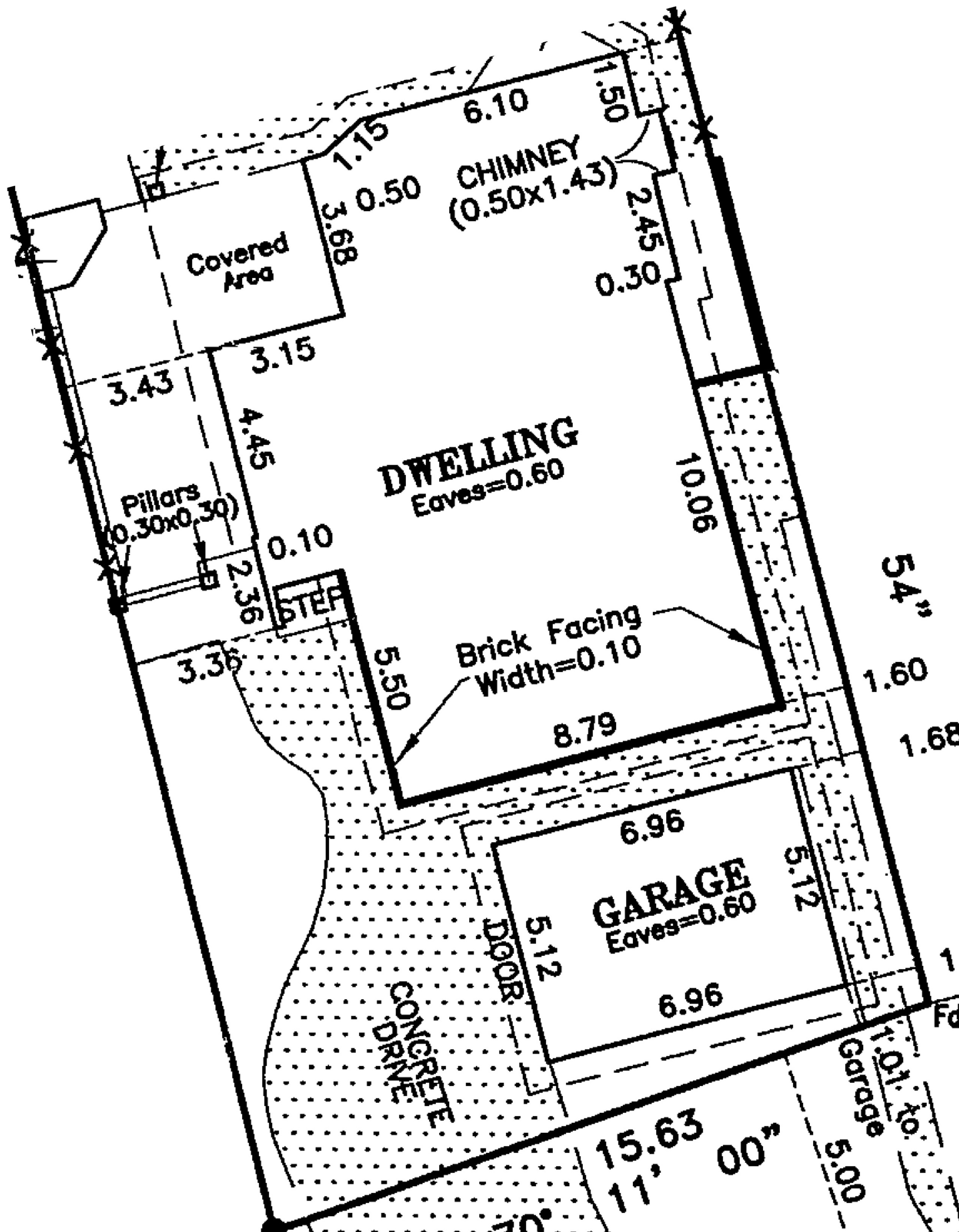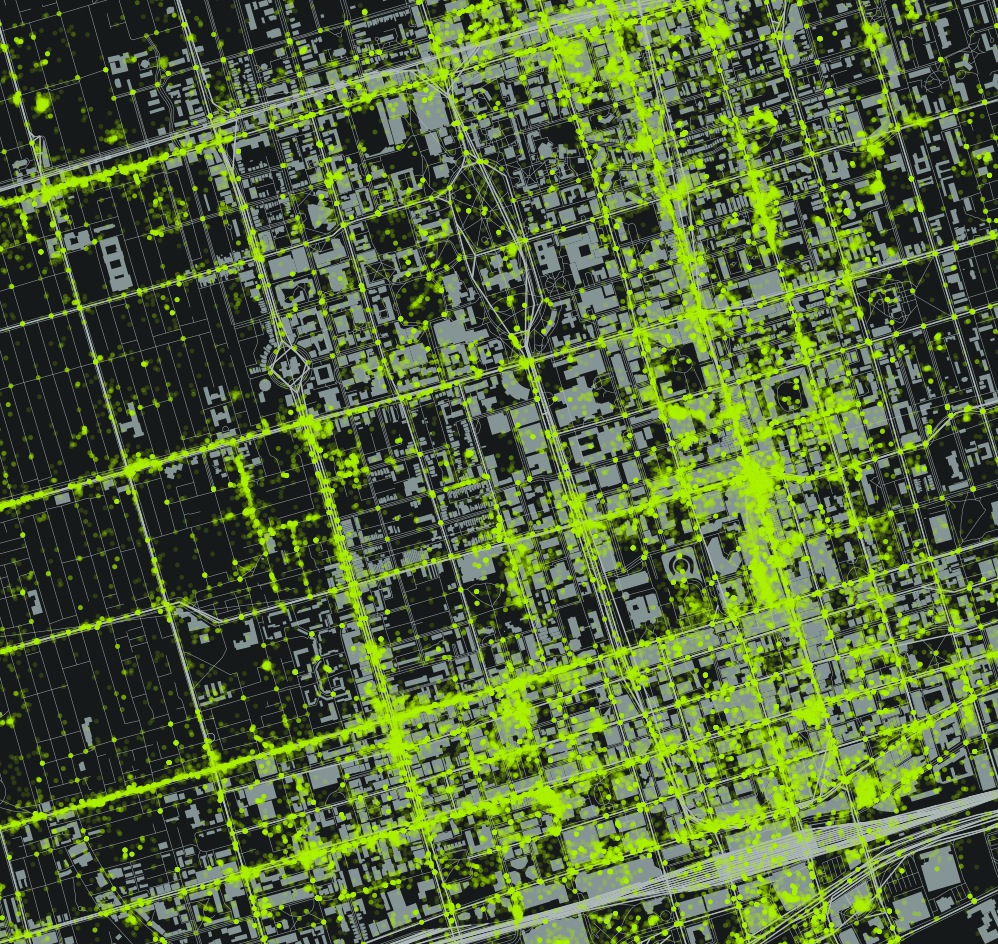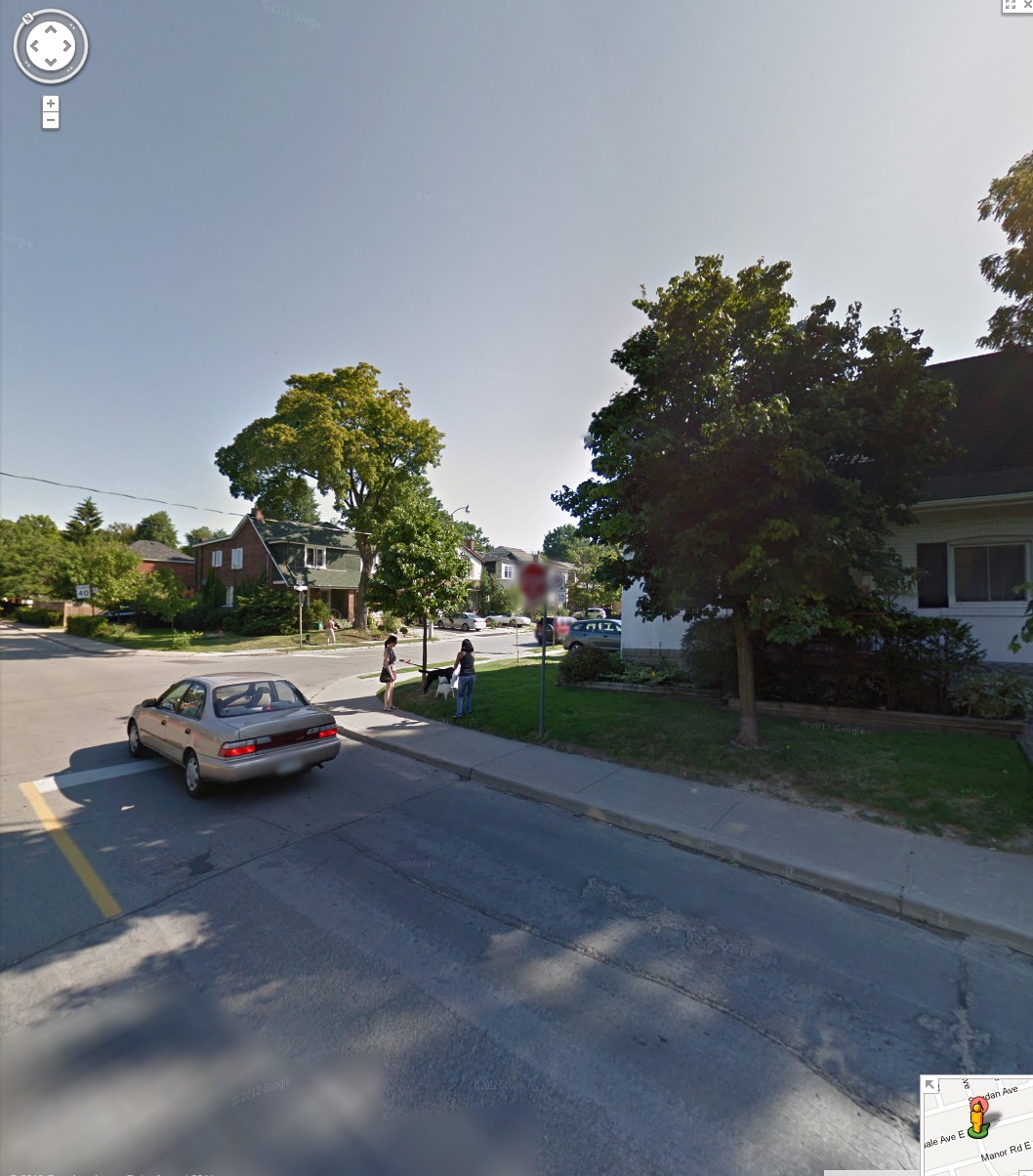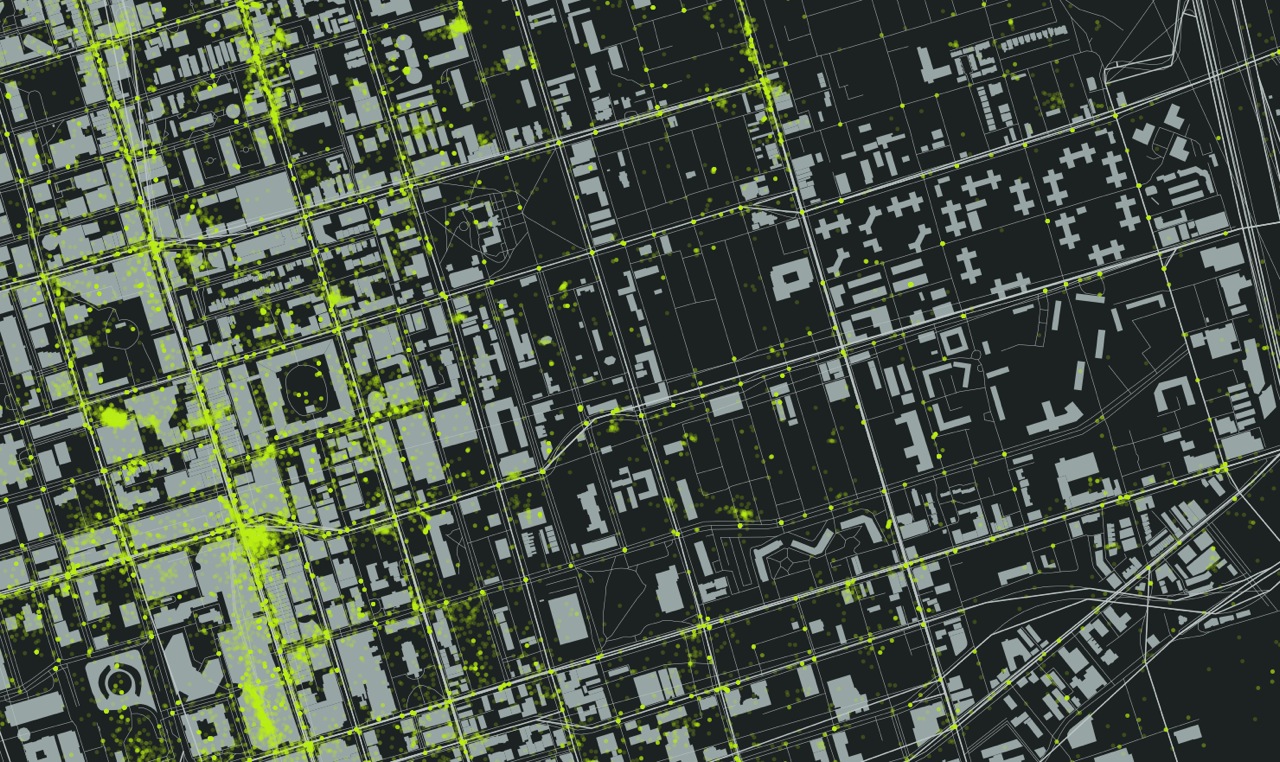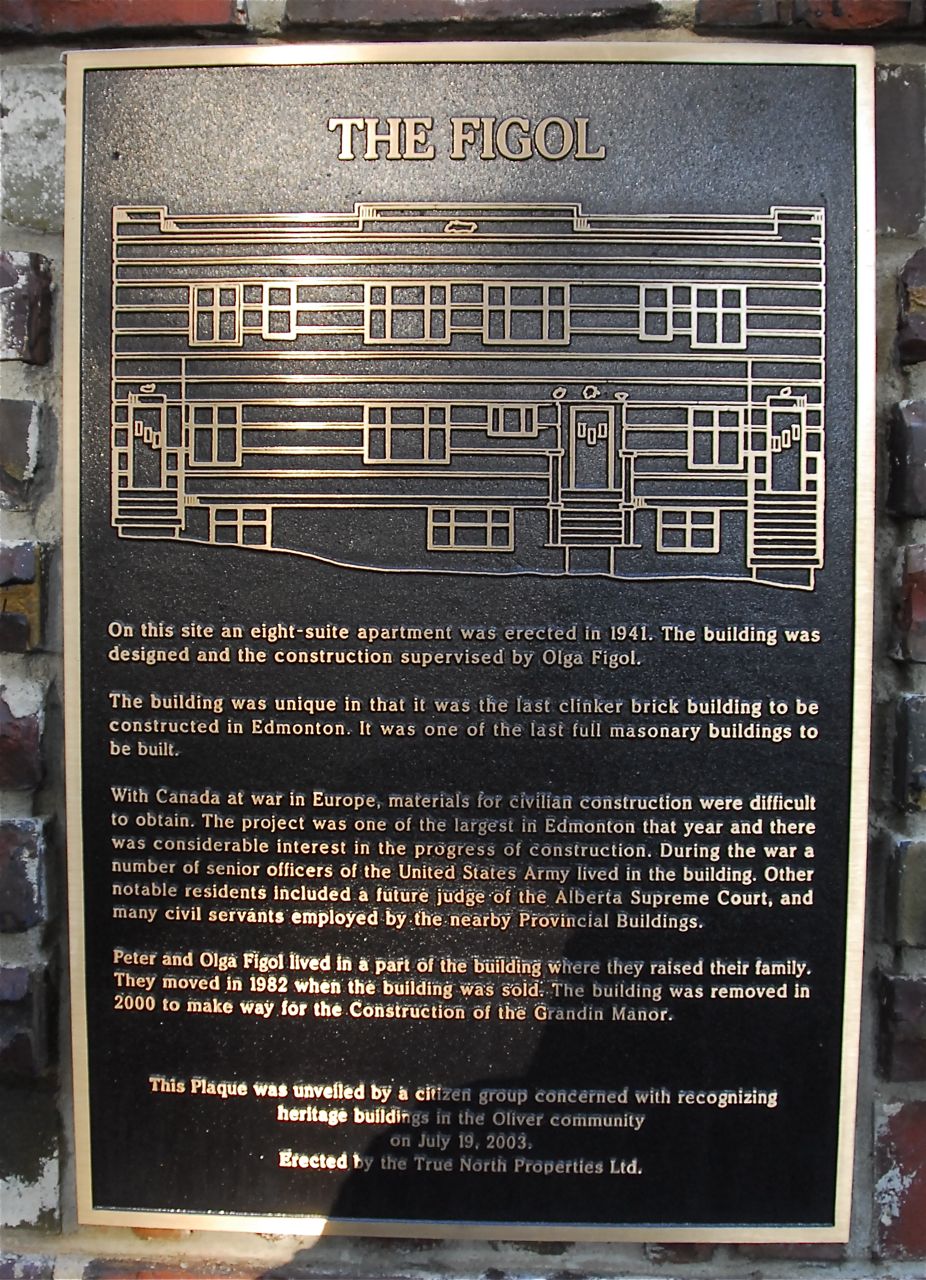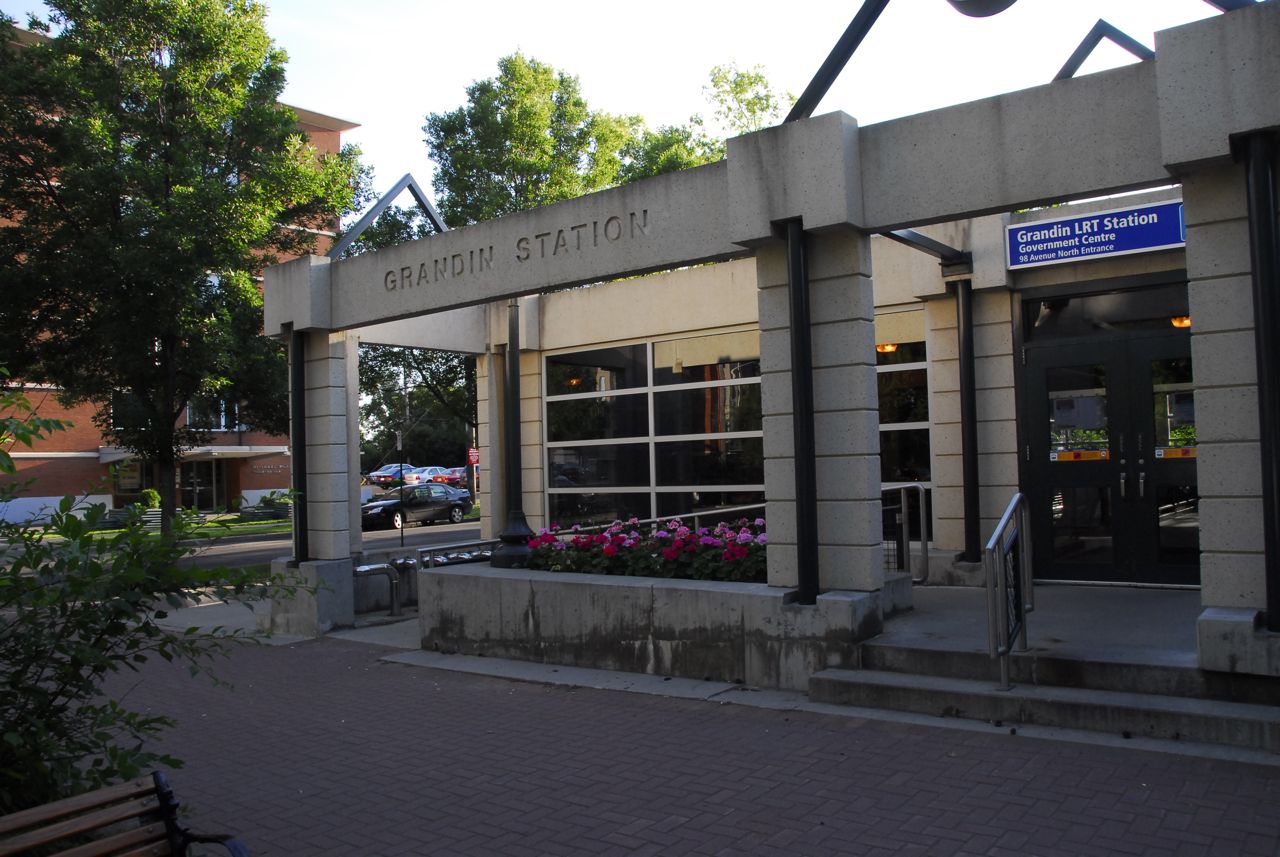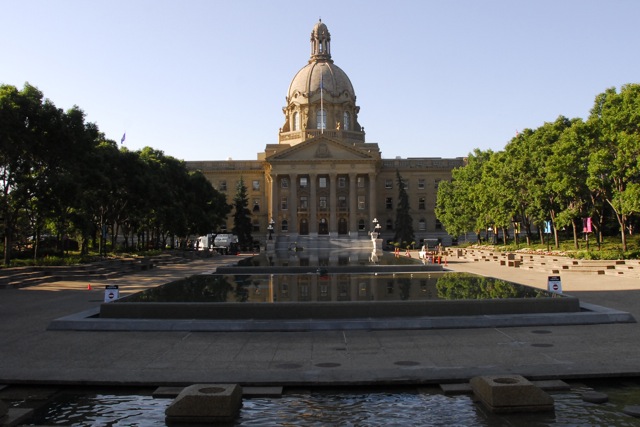Edmonton's Residential Development Permit Process is Broken
The City of Edmonton's residential development application process is broken. I had a horrible experience that could have been much easier, less time consuming and a lot less costly. Here is my story, the issues that I have with the process and some thoughts on how to improve the process.
The project
Our project was to add 10 square meters to the north portion of the garage, and in the process fill the 1.51m gap between the house and the garage. A window on the south side of the house would have to be moved, as well as a so called 'man door' on the north side of the garage. It's a relatively simple project, and I thought an easy ask of the City. Because I have a background in geography (and could not find someone to do the drawings), and have done many to-scale drawings in the past, I decided to do the following myself, which I put together in a 13 page PDF:
- A rationale and justification for the project
- A site plan (from the RPR)
- A floor plan
- A south and west elevation
The PDF also included 12 photographs of the houses on the blocks to the east and west documenting that an attached garage was normal for this neighbourhood. I also addressed the concerns raised in the City of Edmonton's Mature Neighbourhood Overlay. Specifically:
- A variance was identified in that the garage was within 3m of the property line (the variance already exists, and we would not change it by building on the north side of the garage);
- The total footprint of the property was 2% over the allowed ratio (to address this, we offered to remove a small shed in the back that is considered part of the calculation);
The process
I met with a City of Edmonton Applications Officer. We had a nice discussion, and he offered some advice that would help with my application, and assured me that all of the elements needed were present and adequate. I left, modified some of the documentation, and emailed hime the PDF on 21 March. The I waited. I emailed 3 times over the next three days to ensure that the applications officer got my file. He did. I emailed several more times, and called regarding the progress of my application - I even went so far as to call 311 to get the development officer's name and phone number. I called several times to no avail.
I did not hear back until 03 May, when I received an email that stated:
I have received your application back from the development officer They can not make a decision on what has been provided. They would require scaled drawings of the house, floor plans, elevation drawings and a site plan showing setbacks from the property lines.
When I discussed the outcome with the applications officer I asked if I could phone the development officer. I just wanted to talk with a decision maker to explain what I wanted to do. I was told that '...it was not a good idea...' the development officer in question was not approachable. I felt like my application was being judged by criteria not mentioned anywhere (i.e. that my drawings were not done by a professional), and that there was not one person with whom I could talk to about it.
Needless to say, I was disappointed for a couple reasons - (1) I was misled into thinking that my application was adequate when it was not, (2) I was not able to talk with the decision maker - I planned on re-applying and wanted to understand the requirements, and (3) I felt like this was a closed and adversarial process.
Over the next weeks I was able to find a person to make the drawings, and was able to reapply with professional, stamped drawings and a block face plan for my street. I was turned down again, so I immediately appealed and took my development application to the development appeals board.
The appeal
This was an interesting process for a few reasons:
- The Development Appeal Board is independent from the City of Edmonton, with board members being appointed from the public.
- Their process and requirements are well documented and were discussed with me at great length by a planner who works with the appeals board.
- They provided a checklist of requirements, a timeline with the expected date of the hearing, and an phone number to call if I had any questions! This is in stark contrast to my previous experience.
- They provided a deadline for presentation materials, and what they should consist of.
- They also suggested that I talk to my neighbors within 60m of the property to see if they had any issues. I did, and my neighbors had no issues.
In fact, 2/3 of my neighbors have had a similar experience with the city's development process, and signed my sheet on principle. They pitied my this 'ridiculous' process and it worked to my benefit.
I presented to the appeals board, answered a few questions and waited for the answer. For the first time in since my first discussion with an application officer 7 month prior, I felt like I was talking to the right person, like I was being heard and that I would be given a reasonable answer. 20 minutes after my presentation I was told that I would receive a development permit in the mail.
Recommendations and conclusions
In reflecting on the process, some weeks after we received the development approval, I think the most pertinent issues relate to transparency of process, including communication, and providing process support. My recommendations:
- The City of Edmonton should have a step-by-step guide to residential development applications, from where to get drawings done, to all of the official and unofficial criteria for an application. This process should be open to all home owners, just those who hire professionals to do the drawings and project manage the process. A citizen with a scaled and clear drawing on graph paper should be treated as equally as those with professional drawings and a contractor well versed in the process.
- Assign a main contact within the development application department who can address any questions related to an application.
- Allow the applicant to talk to the decision maker.
- In this role, the City is providing a service while enforcing / upholding a set of by-laws. The application and development officers should have adequate communication and collaboration training. The application process SHOULD NOT be adversarial.
Toronto Tweets
There is an emerging narrative that characterizes Twitter as a tool of public engagement that can augment more traditional means of consulting with the public (for instance, see here for Environment Canada's commitment to "...implementing more avenues to facilitate online connections with partners, stakeholders and interested members of the Canadian public") . While there is no doubt that there are many many people who use Twitter (it is reported that there are over 200 million active Twitter accounts) as a mean of conversing with their elected officials, it is important to remember that Twitter does not include all voices within our Canadian cities. This blog post is an attempt to understand who might, in fact, be Tweeting within Toronto in a effort to understand who might be Tweeting about Toronto. About this map
[mapbox layers='mattdance.toronto_tweets' api='' options='' lat='43.65969596299056' lon='-79.38002295227051' z='15' width='600' height='400']
Above are Twitter maps of Toronto that represents all of the geolocated tweets for Toronto in 2011, about 1.5% of the total Tweets (in other words, 98.5% of Tweets are not location enabled). The Twitter data were provided by Trendsmap through John Barratt (thank you!). A full sized version of the dynamic map can be found on the Map Box site.
This was a challenging data to work with as it is so large. I started in QGIS to understand how the data looked and to pair it down to just tweets within the GTA. I moved the data into Tile Mill by Map Box, and layered Open Street Map data to provide visual context for the tweets. The 'heat map' effect that I used is described here, as I was not able to make the QGIS heat map plugin work, for some reason (please let me know if you can help with this). I plan on learning how to build a PostGIS database on my computer so that I can do this.
The idea for the map and post came from these three beautiful and interactive twitter maps: (1) London, (2) New York and, (3) Melbourne.
Observations and analysis
A closer look at the map reveals very dense Twitter areas and areas that are very sparsly Tweeted. The most densely Tweeted area is bounded by Bloor Street to the North and Lake Ontario to the South, connected by Young Street. There is a greater density along the Lake, away from Young to the West. There are also a small number of ghost Tweets on the lake North of Toronto Island.
These boundaries are visible in the above image. There are also a couple of identifiable hot spots - the Eaton Center, Rogers Center (cut off in the above picture). The areas described by this Twitter Density also corresponds with the tourist and suburban destinations - the areas around Young - Bloor - and Front Street, including the sports stadiums, are not just neighbourhood destinations, but destinations for those interested in shopping or taking in the sights in Toronto.
In contrast, those areas that are strictly neighbourhoods, such as Hillsdale Avenue (running east from Young) do not offer that same density.
The above example shows a middle class neighbourhood within Toronto that does not have a large number of Tweets other than the cluster at the corner of Young Street and Eglington Avenue in the top left of the image. The Mt Pleasant Cemetery bounds the neighbourhood to the South.
In addition, poorer neighbourhoods also seem to have a dearth of tweets. The following image is of the Regent Park area between Dundas and Gerrard.
It is clear from the image that many people are Tweeting on Young Street. You can even see a hotspot in the Eaton's Center and at the south east corner of Young and Dundas. Further east, nothing. From the Regent Park Wikipedia page:
The average income for Regent Park residents is approximately half the average for other Torontonians. A majority of families in Regent Park are classified as low-income, with 68% of the population living below Statistics Canada's Low-Income Cut-Off Rate in one of its census tracts, and 76% in the other (compared to a Toronto-wide average of just over 20%).
Conclusions
I suspect that most of the Tweets that occur in Toronto are from those who live in the region, but who may be downtown for some shopping, to take in a game, or other recreation. I also suspect that a majority of those who live in Toronto are a small portion of the overall Tweets in the area between the Lake and Bloor, adjacent to Young.
As you move from this area, I suspect that a greater portion of Tweets are made by residents of those neighbourhoods, simply because fewer 'tourists' would travel to these neighbourhoods unless there was an attraction, such as shopping or food. Although I am only exploring those ~1.5% of tweets that are geolocated, I feel that these are the Twitter users who are most likely to engage with an Open311type of application, to use their smart phones as a means of communicating location details to their municipality. If this is the case, then those poor areas of the city, potentially the most disenfranchised, will become more so (look at Mark Graham's work mapping the digital divide in Francophone Africa).
Where do accidents happen?
There is currently some debate in Edmonton regarding bike lanes, and the inconvenience that they will provide to drivers. In particular, Mayor Mandel was quoted as saying:
Not that they’re not a good idea, but it just seems someone behind your scenes out there has just decided we’re going to eliminate all vehicles and only have bikes.
In response, I wanted to look at the number of interactions that cars have with bike or pedestrian in Edmonton. The data.edmonton.ca portal had the appropriate data from 2010 - intersection collisions here, and midblock collisions here. I sorted the data for pedestrian and bicycle collisions with vehicles, and I included all data for bikes and pedestrians, regardless of who was deemed to be a fault. I loaded the CSV data into Cartographica, a lightweight Mac based desktop GIS, and used OpenStreetMap as the base layer for Edmonton. The results are below, captured as an image (I will work with someone more capable that me to check the data and to get it on line in an interactive format). Legend: red/yellow diamonds are intersection collisions, blue/blue diamonds are midblock collisions. The numer adjacent to each diamond represents an aggregate of pedestrian/bicycle interactions with motor vehicles. .
Some things to note:
- More collisions happen at intersections (90 in total) than midblock (22 in total).
- The most dangerous intersection in 2010 was Fort Road and 66 Street, with 4 collisions.
- The most dangerous stretches of road were Gateway BLVD north of 51 Ave, 109 Street north of Whyte, and Calgary Trail north of 34th Ave.
- Midblock collisions saw 18 pedestrians and 4 cyclists injured.
- Intersections saw 65 pedestrians and 27 cyclists injured.
Conclusions
There is a greater safety issue at intersections where advanced pedestrian and cyclist activated lights should be installed in conjunction with bike lanes. Furthermore, if the bike lanes are being considered for safety reasons, residential street speeds should be lowered from 50 km/hr to 30 km/hr. There is convincing data that cars travelling slower inflict less damage than tose travelling faster - see this WHO report [PDF].
Finally, if the City of Edmonton were serious here, they could conduct an interesting study to track accident rates with cyclists and pedestrians give the introduction of bike lanes, intersection controls and low residential speed limits.
Why I don't support mandatory helment laws.
Please skip to 4.0 Conclusion for the abridged version of this long post. 1.0 Introduction I wear a helmet when I bike, and cannot imagine cycling without one when either road riding, mountain biking or on a family ride. I am uncomfortable without a helmet and feel vulnerable to injury by cars and my own stupidity - I have fallen off my bike often enough to know that for me a helmet is probably a good idea. Furthermore, I am trying to instill this habit with my children; they always have a helmet on when they get onto any self propelled wheeled vehicle. To my mind, there is no downside to wearing a helmet as long as you cycle within your ability.
But, having said the above, I am not certain that mandatory helmet laws are effective in preventing head injuries. In fact, I wonder if the bicycle helmet debate distracts us from a harder discussion on road safety and risk. I think that it is easy to have a public debate about a fringe group of cyclists and how they should be safer, rather than focus on road safety which would include slower residential speed limits, impact road and urban design, and be more difficult to reach consensus. After all bike helmets save lives, right? I am not sure, and so I am looking to answer the following questions:
A. Do mandatory helmet laws prevent head injuries?
B. What are the consequences, intended or otherwise, of mandatory helmet laws?
C. Are there better ways to protect cyclists?
I am writing within context of Alberta, which has had a helmet law since May 2002 that applies to children under the age of 18. Furthermore, this is a first attempt at understanding a complex issue. Please help me understand you position, comment below!
Please note: I AM NOT ADVOCATING A BEHAVIOUR. I WEAR A HELMET, AND SO DO MY KIDS. YOU CHOOSE WHAT IS BEST FOR YOU!
2.0 Evidence Based Policy I don’t think that it is correct to assume that helmets save lives, just as I don’t believe that climate change is a hoax because it is −20C in Edmonton while I write this. Where there is a hypotheses related to policy, there should be a way of collecting data to test that hypotheses. In other words, good public policy is not made from individual cases, anecdote, or from a gut feeling, but rather should be made from a position of informed choice where all viable options and outcomes are examined through the lens of data analysis. The final policy choices may be made for political reasons, but at least these are informed decisions. Medicine is an example where evidence plays a big role in determining best practices. As discussed here, evidence based medicine (EBM) is the “…conscientious, explicit and judicious use of current best evidence in making decisions…”.
Every time (I hope, but perhaps this is a pipe dream) you go to an emergency department, see a medical specialist, or have a procedure done, you rely on this process to get the best results and safest treatment (otherwise you see a naturopath). Evidence based decision processes do not have to be limited to medicine, we can expect the same rigor for public policy, in general, and within the helmet debate specifically. To that end, I plan on examining the evidence that addresses my questions.
3.0 What does the data say? Three types of data should be considered when assessing whether cyclists, by law, should be required to wear helmets - (1) bicycle / vehicle collisions and (1a) bicycle incidents that are comprised of falls or collisions with stationary objects or other bikes, and (3) emergency room visits related to bicycling accidents. These data should be looked at within an Albertan and international perspective. To give a relative risk, pedestrian data will also be examined. Caveat: I don’t have total numbers of cyclists and pedestrians - so their is some interpretation going on here based on totals numbers.
3.1 Bike, pedestrian and vehicle interaction in Alberta The following data are taken from Alberta Traffic Collision Statistics 2010 (found here [PDF]) , and represent the number of incidents for 2010.
| Road User | Killed (N) | Killed (%) | Injured (N) | Injured (%) | Total (N) | Total (%) |
| Drivers | 185 | 53.8 | 11012 | 60.3 | 11197 | 60.2 |
| Passangers | 65 | 18.9 | 4528 | 24.8 | 4593 | 24.7 |
| Pedestrians | 35 | 10.2 | 1129 | 6.2 | 1164 | 6.3 |
| Motorcyclists | 31 | 9.0 | 683 | 3.7 | 714 | 3.8 |
| Bicyclists | 6 | 1.7 | 467 | 2.5 | 467 | 2.5 |
| Other | 22 | 6.4 | 450 | 2.4 | 462 | 2.5 |
| Total | 344 | 100 | 18253 | 100 | 18597 | 100 |
These data were copied from Table 3.1 of the Alberta Traffic Collision Statistics, 2010
3.1.1 Observations I am surprised that more pedestrians were killed and injured than bicyclists in 2010. 1164 pedestrians (6.3% of the total) as compared to 467 bicyclists (or 2.5% of the total). These are interesting numbers, but not really relevant unless we know the total number of pedestrians in Alberta vs. bicyclists. Or even better, the total number of kilometers walked by pedestrians vs. the total number of kilometers cycled by bicyclist. In this latter case, we could then calculate injuries and deaths per kilometer travelled for each case. It would also be interesting to factor motorcycles into this mix. A side note. The raw numbers clearly indicate that about 2.5 times more pedestrians were killed than cyclists in 2010 and yet no one is suggesting that pedestrians wear helmets.
3.1.2 Other observations from the Traffic Collision 2010 report From the same report, Table 9.4 indicates that “Casualty rates per 10 000 population were highest for persons between the ages of 15 and 19”. The lowest rates were for those under 5 and over 55. 27.1% of bike accidents due to the cyclist disobeying a traffic signal, and 13.5% due to the cyclist failing to yield the right of way at an uncontrolled intersection.
From Table 9.3, 9.2 and 9.1 - most accidents occurred on weekdays between 3 − 7PM (rush hour), in June. From Section 8 of the report; Pedestrians faced the similar hazards, with most vehicle, pedestrian interactions occurring during rush hour, in October. It is interesting to note the language of the report points to the actions of the drivers being responsible for pedestrian injury (rather than pedestrians being responsible for their own injury) or death, versus the action of the bicyclist being responsible for their own injury or death.
3.2 Cycling rates and ER admittance The section will draw upon a PhD thesis, from the University of Alberta, written by Mohammad Karhaneh in 2011. Commentary and insight on this thesis was found here. . Karhaneh notes the following based on pre- and post-law observational studies completed in 2006:
- There was a large decrease, 56%, in children’s cycling from 2000 to 2006.
- There was also a decrease in teenage (13-17YO) cycling at 27%
- A 21% increase in cycling for adults.
In his dissertation, Karhaneh simply notes a decease in the number of people seen in the ER as a result of cycling injury. He does not create a ratio of cycling injury to the number or rate of cycling in the population (from cyclehelmets.org). In contrast to the decline in cycling, the rate of injury seems to have gone up after a mandatory helmet law was legislated. As cyclinghelmets.org notes:
“The number of children treated in emergency rooms for non-head injuries was an average of 1,762 per year in 2003-6 compared with 1,676 in 1999-2002, despite there having been a fall of 56% in children cycling over the period. For teenagers the average number of injuries rose from 870 to 1,101 per year while the amount of cycling went down by 27%.”
4.0 Conclusion
This is a complex issue that involves many factors, and I have only offered a slice of the available data, with some commentary that makes sense to me provided by cyclehelmets.org. I have not touched on most of the available data, nor have I explored the physical limits of helmets as protective equipment (see here [PDF] for an overview). I have also neglected to look at injury rates in other jurisdictions that have slower residential speed limits, dedicated cycling lanes and a stronger bike culture. I could complete a PhD on this question, and in fact some have - perhaps this complexity and depth of information is a barrier.
To summarize, it seems that helmets are of use for a limited population in certain circumstances, as in children cycling at slower speeds who fall a shorter distance onto smooth ground. As soon as the speeds increase, and the falls become more complex (uneven ground, impacts with other moving objects such as cars, etc.), the protective benefits of a helmet are negated. Male children 15 - 19 seem to be the most at risk of injury - the data indicates that they are, as a population, more reckless, and take greater risks beyond the capacity of a helmet to manage. In fact, it is speculated, that if they were not wearing a helmet, that 15-19 YO males might not take so many risks. In other words, the helmet was perceived to offer more protection than it does. This finding can be extrapolated more widely to account for the general increase in head injury found in Alberta AFTER the introduction of bike helmet laws. People take more risks when they think they are protected + the limited protection afforded by a helment = more cycling injuries.
I also got the sense from the data that a culture of cycling was protective against injury for those who commute. Dedicated bike lanes, more bikes on the road and drivers who were more aware seems to make roadways safer. I also wonder about residential speed limits for overall road safety. What if we were limited to 30KM/HR rather than 50?
Finally, the data also seems to indicate that the perception of cycling as a dangerous activity dissuades people from riding, leading to two unfortunate outcomes: (1) those who do not cycle, don't gain the health benefits, and this could be significant given increases in obesity, and; (2) spontaneous Bixi Bike type trips are less likely to happen in those jurisdictions that have helmet laws.
“In general the rate of head injuries is declining, but this is not consistent across the country, nor is it attributable to legislation as some provinces with legislation experienced a decline while others did not.” Middaugh-Bonney T, Pike I, Brussoni M, Piedt S, Macpherson A, 2010. Bicycle-related head injury rate in Canada over the past 10 years. Injury Prevention 2010;16:A228.
images of our city: ezio farone park
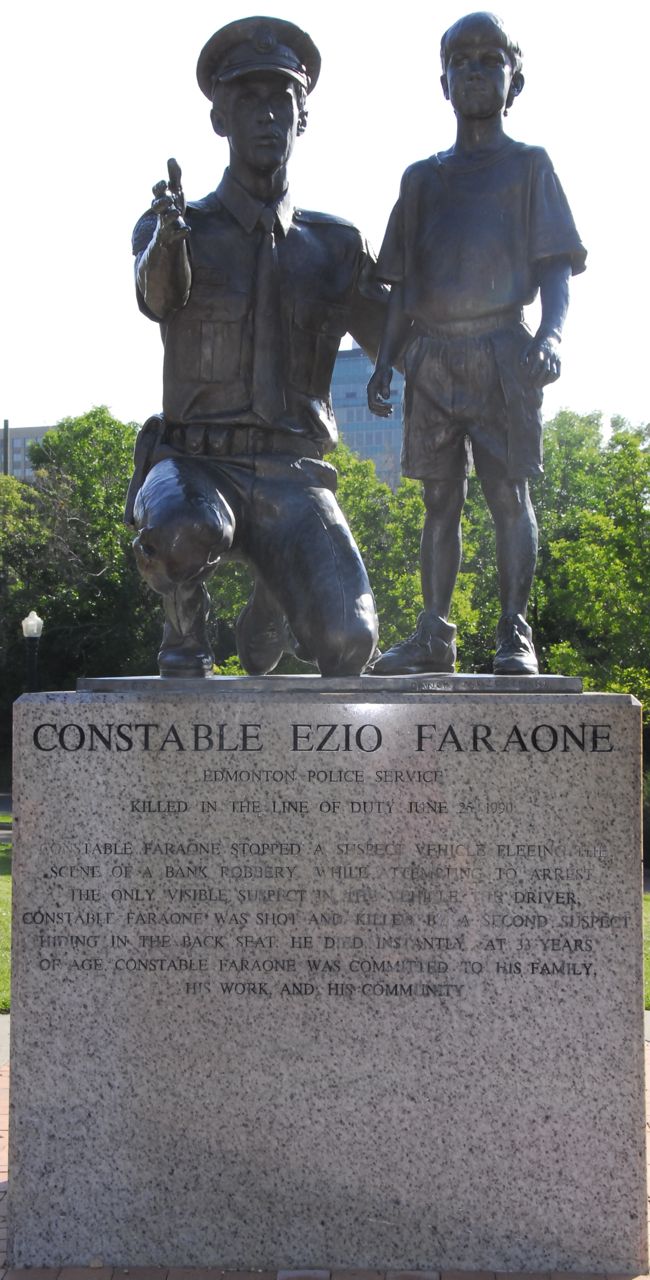 Everyone knows Ezio Farone Park. Its the park at the top of the stairs adjacent to the Glenora Club, and is a node between the southside and downtown; the top of the bank with the river valley. I lived for years at 100 Avenue and 110 Street and love how cycling and pedestrian traffic flows north / south through Ezio. On winter days while walking down to the Kinsmen, I could feel the temperature drop as I descended down the stairs into the River Valley.
Everyone knows Ezio Farone Park. Its the park at the top of the stairs adjacent to the Glenora Club, and is a node between the southside and downtown; the top of the bank with the river valley. I lived for years at 100 Avenue and 110 Street and love how cycling and pedestrian traffic flows north / south through Ezio. On winter days while walking down to the Kinsmen, I could feel the temperature drop as I descended down the stairs into the River Valley.
Ezio Farone park is named after Constable Ezio Farone, a member of the Edmonton Police Service who was killed in action on June 25th, 1990 (from Crime and Punishment website here). While the park is lauded by the running and stair walking community, it is more than just a stairway to fitness heaven. Ezio Farone is a hub of transportation and offer some of the best views of the River Valley, the University and the High Level Bridge. Just check out a Flickr Search to see the great views offered by the park. Furthermore, Ezio provides the best vantage point for the Canada Dat fireworks, as is evident from Flickr.
But, more importantly, Ezio's place in Edmonton is based on several design choices that I think work in the park's favour. The park flows north to access points at (1) 110 street, (2) to the bike trail that parallels 109 street, and; (3) pedestrians can walk up 111 street.
The central part of the park has a few paved trails that connect with the High Level Bridge, stairs adjacent to the Glenora Club, and paved paths that run to the west adjacent to the Victoria Golf Course. It is a true urban park offering great access and is used by people seeking exercise (boot camps, stair running), strolling or simply sitting around. Walking up 100 street offeres access to one of the heritage communities in Edmonton, and to the Grandon LRT station.
Up on the right near the Copper Pot restaurant stands a parkaide next to a hight rise building. A section of the parkaide is distinguished because it is constructed out of clinker brink, by Peter and Olga Figol. Clinker brick is baked at a very high temperature rendering the bricks denser and less pores that normal bricks, they also represent an 'Arts & Crafts' style. Clinker bricks are not used as building materials, and are rarely seen in Edmonton.
The escalators from track level to the Grandin Station feel deep and steep, and when you emerge from the tunnel on a summers day, you are met by tall mature trees and an urban environment that is saturated with green space . This community, part of Oliver, flows well from the River Valley, through Ezio Farone and connects with Jasper Ave a few blocks to the north. Groceries, local and chain coffee shops and cloths shopping are all accessible within a short walk. While each of these elements on its own is not remarkable, in combination they allow this community to shine.
images of our city: legislative grounds
 One of Edmonton's most used areas, and one of my favorite spaces, is the legislative grounds. The ledge is iconic in Edmonton with its domed roof and spire raised over the downtown, and is visible from across the river to the south, down 108th Street and from the east as well. The Legislature Building is situated on 23 HA of parkland that represents a history going back to the late 1800's when these grounds were a 5-hole golf course. A history of the Legislative Grounds can be found here (PDF).
One of Edmonton's most used areas, and one of my favorite spaces, is the legislative grounds. The ledge is iconic in Edmonton with its domed roof and spire raised over the downtown, and is visible from across the river to the south, down 108th Street and from the east as well. The Legislature Building is situated on 23 HA of parkland that represents a history going back to the late 1800's when these grounds were a 5-hole golf course. A history of the Legislative Grounds can be found here (PDF).
What I like about the ledge is its status in Alberta, as the seat of government, and its use by the citizens of Edmonton and Alberta. The grounds represent the diversity of people that can be found within Alberta, with symbols ranging from aboriginal (a totem pole) to Asian (Korean and Japanese symbols), including several memorials to workers and the Holocaust.
The ledge grounds are welcoming and used. In the summer it is common to see children splashing in the pools to the north of the legislative building, as well as office workers sitting in the sun during lunch and coffee breaks. The grounds also link the north side of the High Level Bridge with downtown, allowing pedestrians and cyclists a traffic-free alternative to their commute. Canada day is celebrated with cycling races, Christmas with lights; Hanukah and other multi-cultural events are also celebrated. Protesters also march to the steps of the legislative building to voice their concerns and disapproval.
These events are significant in that they provide the context for the grounds as being public, open, and inclusive - even democratic. In a time when 'space' is more often private or a weird hybrid of public and private (for instance, Chapters, where you are welcome if you are willing to pretend that you have and want to spend money). These grounds welcome everyone, and people are empowered to experience and interact with others and the space adjacent to our elected government.
One of my biggest concerns with the legislative grounds is currently being addressed. Given the current slate of demolitions in Edmonton, it is encouraging the see that the Federal Building is being refurbished. The renovation began in 2008, and will be completed in 2011 in time for Alberta's 100th anniversary in 2012. The design concept of the renovation includes a west entrance pavilion re-orienting the building towards the legislative grounds and adding to the public space found on the grounds, there will be an additional 650 underground parking stalls added, and a skating rink.
I believe that the legislative grounds provides an interesting and public connection between the riverside and the downtown core. While the extent of the grounds, size and nature of the buildings makes this close to impossible to replicate in other parts of Edmonton, there are design elements worth considering. The linkages between different modes or transportation (transit with a terminal on the east side of the grounds, walking, cycling, parking), activities such as splash ponds, and skating, coupled with public space make this a model to be replicated.
Urban GeoWeb 1
This is an inaugural post, the first of a series that will explore the intersection of the Urban with the GeoWeb and Social Computing. My interest is specific to data visualisation, collaboration and access to resources that will enrich citizens experience living and working in urban environments. The GeoWeb is emerging (has emerged?) as a dominant platform by which people consume, generate and communicate spatially relevant information that is a reflection of their use and experience interacting with urban areas. Social Computing is that cloud of information and people / groups that surrounds us all, and that we access via a mobile devise or computer.
Transit is an obvious way to incorporate several data streams - open transit data which describes the bus schedule and bus stop locations, potentially GPS from individual buses - all displayed on an interactive map interface that supports queries. This is standard. Mapnificent is not standard as it displays all of the Google enabled transit maps in the world, and provide the user travel times. TripTropNYC creates a travel time heat map from any location of New York. Boston's Street Bump app utilises a smart phone's GPS and accelerometer to provide a realtime view of the state of Boston's roads. I love this this type of application development is seeking to crowdsource, through citizen based sensors, less expensive ways to track urban infrastructure.
Sustainable Cities Collective expands on this theme by discussing WikiCity as a way to engage citizens in city improvement:
Local groups all around the world are taking the initiative and are building the infrastructure that governments refuse or are slow to do.
Charlie Williams, an UK based artist, has created some very cool looking Air Boxes which provide realtime feedback to citizens on the quality of their air. These boxes sit at street level and simply shows a red, orange, or green graphic depending on the quality of the air.
Finally, the MIT Sensable City Lab hosted a Future Cities forum that brought together a number of leading thinkers, including Carlo Ratti the Lab's director, to discuss future cities. The video of these talks can be found here.
I'll close with these words from the Future Cites website:
Over the next few decades, the world is preparing to build more urban fabric than has been built by humanity ever before. At the same time, new technologies are disrupting the traditional principles of city making and urban living. This new condition necessitates the creation of innovative partnerships between government, academia, and industry to meet tomorrow's challenges including higher sustainability, better use of resources and infrastructure, and improved equity and quality of life.
A more intelligent Edmonton?
Edmonton is on the cusp of great change. We are moving forward with an expanded LRT line, contemplating (seriously contemplating) building a downtown stadium for the Edmonton Oilers, and building a whole new community on the Municipal Airport Lands. For good or bad (likely good AND bad) we are moving forward and perhaps coming into our own as a major prairie urban center. I feel, though, that this change is in some regards being made with little understanding of the broader context, and that this context isn’t even on the radar in a meaningful way. Let me explain what I mean by this. For me, the best way to understanding something is to try and collect data and explore what those data are saying. And I think that this change is going to generate a lot of data – if we have the foresight and will to collect it over the longer term. Given my predilections towards humanities research and interest in air quality, I propose that we create a three-pronged network of monitors to help us understand the impact of change on Edmonton’s people, build environment, and air quality.
Edmonton’s People Edmonton is home to a great and increasing diversity of people who are impacted by ‘development’ in vastly different ways. For instance, business owners within the downtown core may have a different understanding of the potential benefits associated with a downtown arena than the working poor or other who use the Boyle Street services. The same is true for someone who lives in Riverbend, or downtown. The media is limited in the number of stories that can be printed, and the number of views that can be expressed. But there is another way to include more voices in the debate and as a record of impressions of change. What would it look like to document, through short-recorded interviews, the impressions that this diversity of people has regarding the change that we are seeing? These recordings could be grouped on a web-based map based on the location of the project being discussed. Over time a comprehensive public record could be created.
Edmonton’s Build Environment We are planning some large and impressive projects over the coming years and it would be a shame not to document, in detail, how these projects unfold. Interviewing Edmonton’s People is one approach to documenting these changes, and photographing the changes to the build environment is another approach. But rather than capture these changes with static one-off photos, we could with some thought, engage in a long-term photography project to run in conjunction with the interview project. There are several components to consider: Cowdsource: We can create a Flickr group and encourage citizens to upload their photos here with a geo- and other tags to help sort and understand the context. Time-lapse: Set up a number of self sustaining time-lapse rigs focused on key areas of development (the arena, the municipal airport lands, LRT routes) and let these cameras do their work. A picture a day (or two, or three…) over the course of a year will be a great resource into the future.
Edmonton’s Air Quality Establish a network of volunteers to travel through the city with mobile air quality sensors (there are options with this technology – MIT’s Copenhagen Wheel, or http://sensaris.com/product.html). Current monitoring practice has three sensors in Edmonton, one in the downtown core, located on top of a building. Mobile sensors would offer three benefits over the sensors run by Alberta Environment. (1) Real time data that (2) reflects the quality of the air we breathe rather than the AQ on top of a building in (3) locations that we are concerned about.
There is a lot of room to improve the real monitoring of Edmonton, including perceptions of people, changes in the built environment, and changes in environmental quality. To fully understand how change impacts these things, we should start building out understanding of the current (baseline) data soon.

